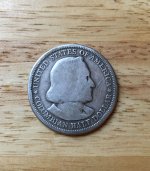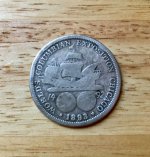secondstar
Hero Member
- Mar 11, 2017
- 790
- 2,940
- Detector(s) used
- XP Deus, Minelab Equinox, Garrett Ace Apex
- Primary Interest:
- Metal Detecting
I went out detecting this morning with a couple of buddies. We decided to work a brush filled, trashy area near a spot that we've been to a thousand times. I worked the area for a few minutes, when suddenly I got a trash tone with an ever so slight good tone mixed in. I circled around the target, and finally honed in on what was definitely a silver half dollar mixed in with trash. I dig, and out pops this beauty;


It's an 1893 Columbian silver commemorative half dollar from the Chicago World's Fair! The obverse side of the coin was designed by Charles Barber, the reverse side of the coin was designed by George Morgan! How this ended up in the woods in Massachusetts is beyond me. I am absolutely hooked on pro zero mode on my At Pro, that's for sure! I've posted a blurb that I found about this coin below, thanks for looking!
"The 1892 and 1893 Columbian half dollars were the first commemorative coins issued by the United States. They were coined to commemorate the World's Columbian Exposition in Chicago. This event, also known as the Chicago World's Fair, was to be held in 1892.
With the cost of the fair ballooning, an enterprising manager of the expo suggested that souvenir half dollars be produced and sold for $1 each to help cover the cost of the exposition. The bill to produce the coin was passed on August 5th of 1892 and called for the mintage of no more than 5 million half dollar coins.
The striking of these coins began with special proof issues on November 19th of 1892 to national fanfare. So great was the fervor that the company that produced the Remington typewriter paid an astounding $10,000 for the first coin struck, an amount equal to nearly a quarter of a million dollars today!
However, these coins are not usually worth nearly that much today aside from the few survivors in very high grade. With a mintage of 950,000 in 1892 and a further 1,548,300 produced in 1893, the Columbian Exposition Half Dollar is the most common type of the entire classic commemorative series."


It's an 1893 Columbian silver commemorative half dollar from the Chicago World's Fair! The obverse side of the coin was designed by Charles Barber, the reverse side of the coin was designed by George Morgan! How this ended up in the woods in Massachusetts is beyond me. I am absolutely hooked on pro zero mode on my At Pro, that's for sure! I've posted a blurb that I found about this coin below, thanks for looking!
"The 1892 and 1893 Columbian half dollars were the first commemorative coins issued by the United States. They were coined to commemorate the World's Columbian Exposition in Chicago. This event, also known as the Chicago World's Fair, was to be held in 1892.
With the cost of the fair ballooning, an enterprising manager of the expo suggested that souvenir half dollars be produced and sold for $1 each to help cover the cost of the exposition. The bill to produce the coin was passed on August 5th of 1892 and called for the mintage of no more than 5 million half dollar coins.
The striking of these coins began with special proof issues on November 19th of 1892 to national fanfare. So great was the fervor that the company that produced the Remington typewriter paid an astounding $10,000 for the first coin struck, an amount equal to nearly a quarter of a million dollars today!
However, these coins are not usually worth nearly that much today aside from the few survivors in very high grade. With a mintage of 950,000 in 1892 and a further 1,548,300 produced in 1893, the Columbian Exposition Half Dollar is the most common type of the entire classic commemorative series."
Upvote
32





 Congrats on the find.
Congrats on the find.
